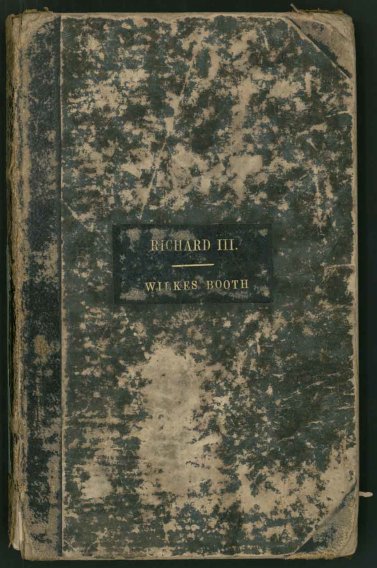AUSTIN: Is this a promptbook which I see before me? Among the items on display in “Shakespeare in Print and Performance,” an exhibition running Dec. 21–May 29, 2016, at the Harry Ransom Center, a research library and museum at the University of Texas at Austin, is indeed a promptbook—and not just any old tattered script. This one belonged to an actor best known for murdering Abraham Lincoln.
“While combing through our promptbooks for candidates to include in the exhibition,” explains Eric Colleary, the Ransom Center’s curator of theatre and performing arts and a curator of the exhibition, “I learned we had John Wilkes Booth’s promptbook for Richard III, with extensive notes about the production written in his own hand. The notes include music cues, blocking notation, technical descriptions, and significant alterations to the script itself.”

That book, a rare find, provides insight into the psyche of one of the most infamous thespians of all time. The revelations came in part from Colleary’s research in the Harvard Theatre Collection at Massachusetts’s Houghton Library and at the Hampden-Booth Theatre Library at Edwin Booth’s Players club in New York City. Examining scripts from versions of Richard III by more renowned Shakespeareans in Booth’s family—his elder brother Edwin and his father, Junius Brutus—Colleary discovered that John Wilkes’s interpretation was quite different, reflecting his personality, even the beliefs that led to his most notorious deed.
“Edwin Booth’s Richard was closer to Shakespeare’s villain, but John’s version is adapted in such a way as to make Richard an almost sympathetic tragic hero, a flawed but morally righteous figure,” Colleary observes. “There are many accounts that suggest this was John’s favorite role, and certainly among his most popular. It is not too much of a stretch to suggest that he saw something of himself in the character of Richard, which is fascinating in light of the later assassination of Lincoln.”
Of course, the exhibition isn’t all about the psychology of assassins. In honor of the 400th anniversary of the dramatist’s death, “Shakespeare in Print and Performance” will showcase a variety of items on loan and from the extensive collections of the Ransom Center, one of the world’s preeminent repositories of material relating to the arts and humanities. The featured artifacts include set designs by luminaries such as Edward Gordon Craig, Robert Edmond Jones, and Norman Bel Geddes; a costume worn by Rosalind Iden in a World War II–era staging of Much Ado About Nothing by one of the U.K.’s leading repertory touring companies; and a copy of Hamlet that belonged to George Bernard Shaw. Both general audiences and practitioners will have much to marvel at.
“The early books section of the exhibition will give theatre professionals an unparalleled look at Shakespeare in the context of his contemporaries,” notes Colleary, “as well as early editions of books Shakespeare used as source material for his plays.”
O brave new world that has such archives in’t!


